This piece is part of a two-part series on Édouard Mendy, Chelsea’s newest goalkeeper. In this piece, I’ll break down Mendy’s aerial ability, distribution and sweeper keeping.
To learn more about Mendy’s shot-stopping ability, check out part one here.

aerial ability
One of the biggest criticisms Kepa Arrizabalaga faced last season was his reluctance to attack crosses and set-pieces. The Spaniard was very reserved — he rarely, if ever, left his line, and it was even rarer to see him claim a corner in his box.
It was so rare, in fact, that it never happened. In the entirety of the 2019-20 Premier League season, Kepa failed to claim a single corner. He attempted to catch four of them, punching two away safely, one into danger and completely missing another.
In terms of crosses in general, Kepa’s numbers aren’t that much better. Though he posted the ninth-best cross-collection efficiency in the Premier League last season, his 18 crosses stopped were the fifth-lowest among goalkeepers with 30 or more league starts.
Kepa’s bashfulness is a significant reason why his own teammates seemed to lose confidence in him. In one game against Liverpool, his teammates can be overheard screaming his name after he let a dangerous cross enter his six-yard box unchallenged.
Given Kepa’s lack of command in his box, an efficient cross collector was high on the list of needs for a new Chelsea goalkeeper. And I’m happy to report that Édouard Mendy is not only very good at collecting crosses, but it’s probably his best strength as a goalkeeper.
From a statistical standpoint, Mendy wipes the floor with Kepa. The Senegalese goalkeeper faced the same number of corners as Kepa despite playing nine fewer league games in 2019-20. But that’s where the similarities end. Mendy attacked 16 of those corners, and he made contact with all of them. He successfully caught eight corners — half of the total amount of corners he tried to attack — and successfully punched five of them away. He only punched three of those corners into a dangerous area.
According to work down by goalkeeper analyst John Harrison, Mendy’s corner-collection numbers were so good last season, they’d rank him among the three best corner collectors in the entire Premier League, ahead of even Alisson Becker.
Mendy was also very efficient from a general cross-collection perspective. In the 2019-20 Ligue 1 season, Mendy successfully stopped 20 of the 197 crosses he faced for a 10.2% success rate.
The 28-year-old goalkeeper was among the French league’s top five most efficient cross collectors, and among the top 15 most efficient cross collectors in the big five European leagues.
So, what makes Mendy such an efficient cross collector?
For one, Mendy is a tall goalkeeper. The Senegalese international stands at 6 ft 5, which makes him among the tallest goalkeepers in the big five European leagues. With his arrival into the Premier League, he also becomes the league’s tallest starting goalkeeper, according to official measurements. (Note: Nick Pope’s official height is 6 ft 3, but he contends he’s 6 ft 6).
This obviously helps him claim high, dangerous crosses. His standing height already puts him at an advantage over the average player, and if you factor in his jumps and the length of his arms, it’s easy to why he’s able to reach over opponents most of the time.
But being tall doesn’t mean necessarily translate to being an effective claimer of crosses. Three of the five most efficient cross collectors in the big five European leagues last season were 6 ft 2 or shorter, while the likes of 6 ft 5 Gianluigi Donnarumma and 6 ft 6 Thibaut Courtois failed to make the top 20. So citing Mendy’s height as the only reason why he’s able to successfully claim high balls would be lazy journalism.
Instead, let’s take a look at his jumping ability, compliments his towering height. The Senegalese goalkeeper is very explosive; he’s able to get a lot of airtime when he jumps, and he’s able to reach heights that would make even Cristiano Ronaldo blush.
As an example, let’s break the above picture down. In this scenario, Mendy is challenging LOSC Lille’s Jonathan David for a high ball. He leaps into the air and gets a firm two hands on the ball. David had no chance of getting to this cross.
David stands at about 5 ft 9 (175 cm) tall. He’s standing pretty upright in this photo, so I think it’s safe for me to use David’s height as a measuring stick of sorts.
Given that, if we measure the distance between Mendy’s lowest point — his left foot — and the ground, it appears as though Mendy jumped somewhere under half of David’s height (2 ft 9 / 87.5 cm). This is obviously a very rough and very unscientific observation, but I hypothesize Mendy leaped somewhere between 65 cm and 75 cm into the air.
(For reference, Cristiano Ronaldo, who is renowned worldwide for his jumping ability, produced a 71 cm-high leap in a 2019-20 Serie A game against Sampdoria).
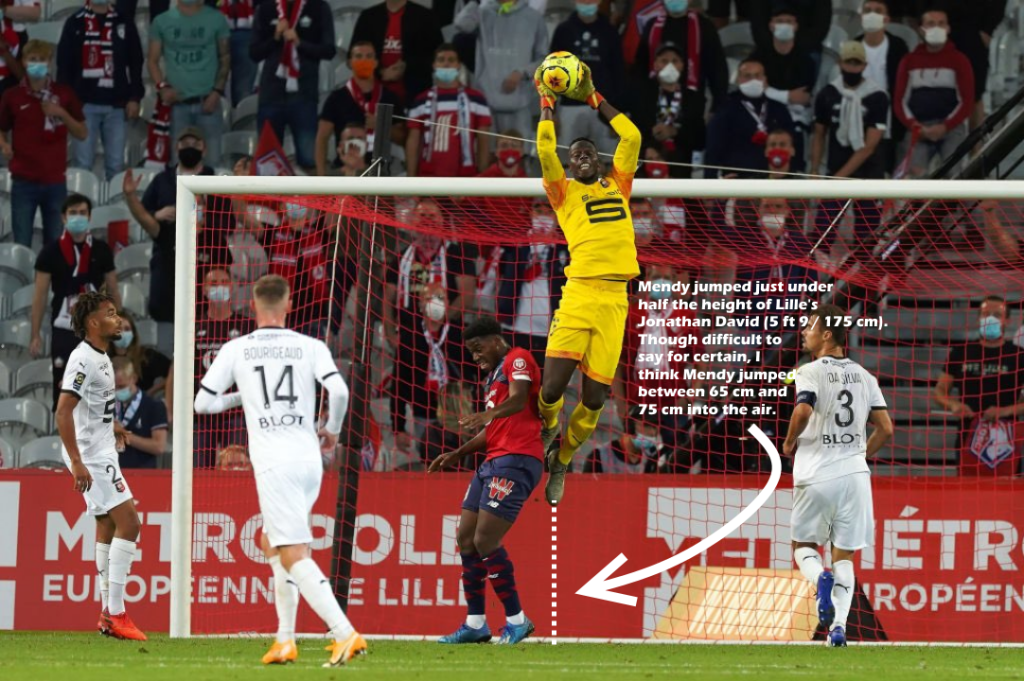
Incredible leaps such as this one are the norm for Mendy, and they’re a reason why he’s able to reach high crosses with relative ease. In this example, the ball is over eight feet in the air when Mendy claims it, which is too high for the average goalkeeper to make substantial contact with it, let alone the average outfielder.
Mendy’s explosive jumping ability gives him a significant advantage because he can reach these extremely high balls before any player even has a chance at making contact with it. He’s able to diffuse situations before there’s even the threat of a header or an overhead kick.
Sure, his incredible height helps in these scenarios. But it’s this rocket-like jumping ability that allows Mendy to lift himself over opponents and claim crosses without facing much aerial pressure.
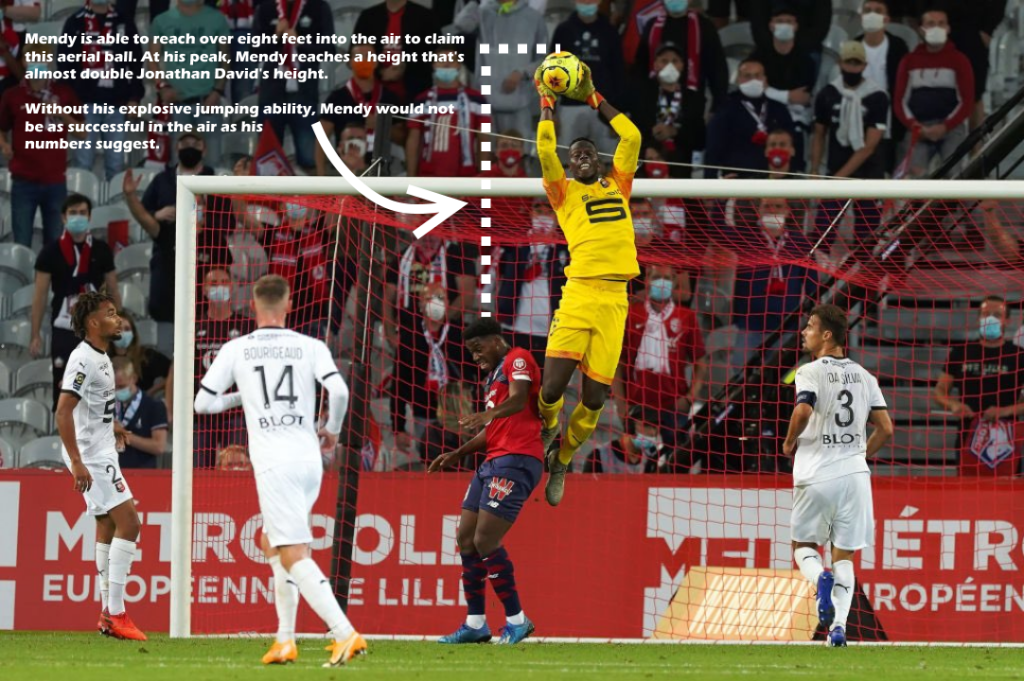
Mendy’s ground game also plays a role in his aerial superiority.
On the ground, Mendy is a very quick and surprisingly agile goalkeeper. Most goalkeepers his size tend to be a bit slower on their feet than the average goalkeeper, but Mendy moves around his goal quickly and efficiently.
Part of this is because Mendy uses a lot of big steps and big hops to move around his box. These big steps help him cover a lot of yards quickly, which helps him command his box well.
Take the following play as an example. When the set-piece is first struck, Mendy is positioned with a foot on the six-yard line. As the ball is played into his box, he takes five or so big steps forward and to his left. These steps put him in the optimal position to jump and claim this high ball.
Given the presence of two attacking players in the area where Mendy claims the cross, it’s fair to suggest he wouldn’t have been able to make such a clean catch had he been a bit slower and reached this delivery late.

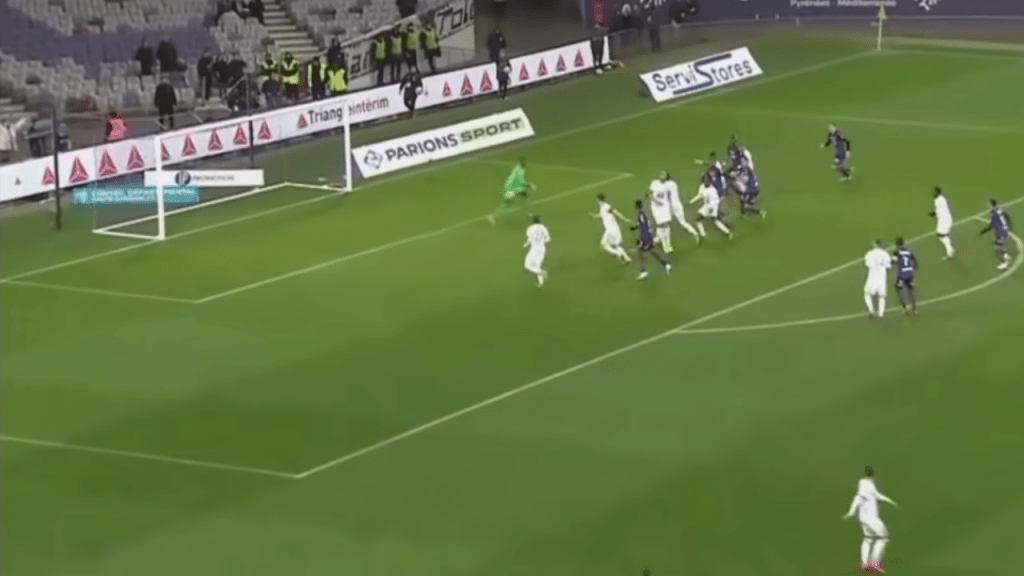
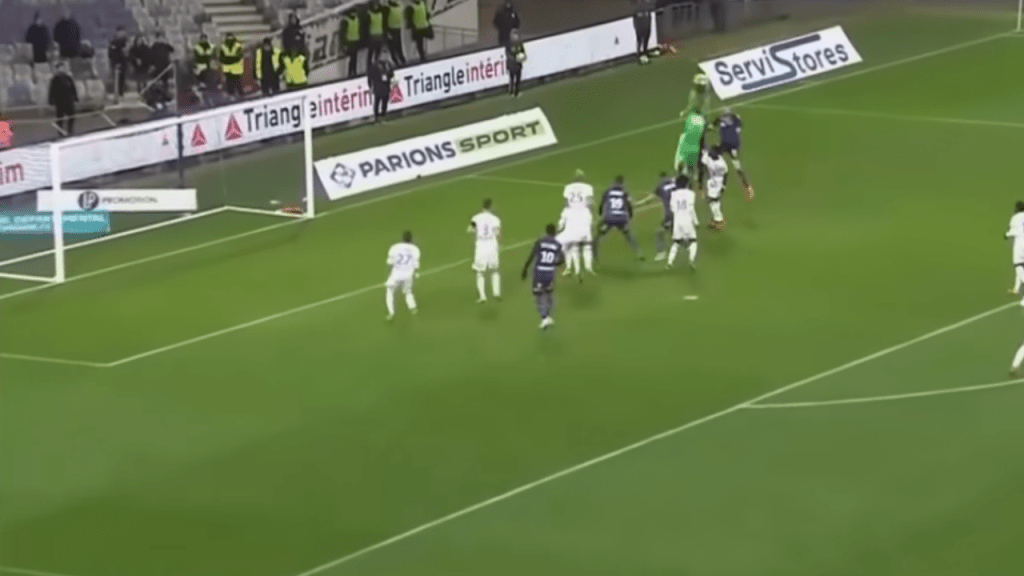
Mendy’s also a swift and intelligent mover. He’s able to identify pockets of space in crowds, and despite his size, he can move swiftly between groups of players. This intelligence allows Mendy to get a clean catch on most crosses, which decreases the risk of a fumbled claim or an awkward parry.
An example of this was seen in a Coupe de France game from earlier this year. As this corner from Mendy’s left side is played into the box, two attackers rise in order to meet the delivery. There is little space between them, and if a goalkeeper were to challenge them, it’s likely the goalkeeper would’ve run into either player, maybe even both of them. The potential impact would’ve hindered the goalkeeper’s ability to cleanly catch the ball.
But thanks to Mendy’s swift feet and awareness, he’s able to identify this pocket of space and quickly move his body into a position between these two attackers. This allows Mendy to cleanly claim the ball and start a counterattack.

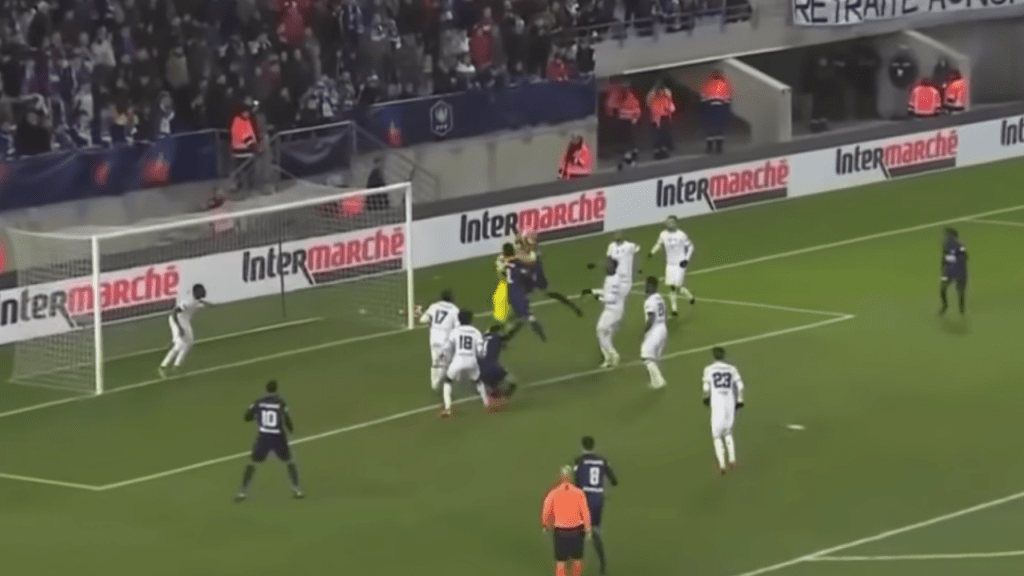
If I had to nitpick, I’d say Mendy’s punching is not the best. There are times when he fails to get much power behind a punch, and that sets up a dangerous second-chance opportunity. Based on the clips I’ve seen, most of his punches don’t seem to leave his 18-yard box, which could be an issue when dealing with a crowded-box situation such as a corner or indirect free kick.
In my opinion though, Mendy’s strengths in the air far outweigh his one weakness. He’s an excellent aerial goalkeeper — his height, explosive jumping power and swift ground game combine to make him one of Europe’s best goalkeepers when it comes to dealing with crosses. And for a club like Chelsea, who had to endure with the reserved and subdued Kepa throughout the past two seasons, Mendy’s aerial quality is something to look forward to.

DIStribution
From a statistical perspective, it seems like Édouard Mendy prefers playing long balls as opposed to short passes.
In the 2019-20 season, Mendy attempted nearly 800 total passes, including goal kicks. Most of these passes were played over a distance of 40 yards; the average length of his goal kick was 47.6 yards, and the average length of his passes (excluding goal kicks) was 39.4 yards.
This shouldn’t come as much of a surprise given Mendy’s success with finding his teammates with long balls. Last season, Mendy posted a long pass completion rate of 51.4%. Not only was that the second highest rate of its kind in Ligue 1, but it also made him one of just 10 starting goalkeepers in the big 5 European leagues to complete over 50% of their attempted long passes.
Mendy’s long-ball preference could be something for Chelsea to consider. Last season — Frank Lampard’s first as Chelsea manager — saw the club’s goalkeepers average 32.3 yards covered with their passes and 38.8 yards covered with their goal kicks. Both averages are significantly shorter than those belonging to Mendy.
Does this mean Mendy will struggle to adapt to a style with more emphasis on shorter passes? Not really. According to WhoScored, Mendy completed 294 of the 298 short passes he attempted in Ligue 1 last season. Those 294 short passes were among the top 10 most completed by French league goalkeepers last season, and his completion rate of 98.6% was among the highest in the league.
It’s also important to note that Mendy’s tendency to play long balls was likely down to Stade Rennais’ tactics. The French club preferred pinging long balls to their midfielders and attackers as opposed to handing the ball off to nearby defenders, and that philosophy likely rubbed onto Mendy’s own style of play.
Given that, it’s not illogical to think Mendy can adapt to Chelsea’s tactics — which encourage a mix of short and long passes — after a few appearances and training sessions.
Mendy is equally as confident as a ball handler as he is as a ball distributor. The Senegalese international has a good first touch and isn’t afraid of challenging opponents head-on. He’ll even sometimes invite attackers to approach him only to surprise them with a fake pass or hip fake.
Take this play in a French league match. Mendy receives the ball from his teammate about seven yards away from his line. With two attackers approaching him, Mendy takes a heavy touch to his left, dragging one of the opponents along with him.
As Mendy gets closed down, it looks as though he’s going to challenged off of the ball. But with a swift fake, he drops the attacker onto his backside and turns the ball into the opposite direction, opening space to pass it to a teammate at the edge of the box.
Another goalkeeper might’ve lost their composure and turned the ball over, but not Mendy. The 28-year-old goalkeeper’s cool-as-a-cucumber attitude and incredible confidence allow him to exploit opponents in situations that are normally unfavourable to the goalkeeper.




That said, Mendy’s confidence will sometimes tread into recklessness. In some situations where a more controlled approach would be the best way to go about things, Mendy will make things more difficult for himself with an unnecessary heavy touch or delayed action.
Take this play against Olympique Marseille. This pass is played on the ground to Mendy, and while there is a free attacker charging at him, Mendy is in yards of space and is very open to receiving this pass.
Given the unchallenged nature of this pass, you wouldn’t expect Mendy to have too much trouble trying to control it. He should be able to handle this pass cleanly and move this play along without inviting pressure.
But Mendy tries to be skillful, and he nearly makes a mess of things. With his first touch, Mendy flicks the ball up to his upper body and chests it into the air. But he mishandles the flick and adds unnecessary spin to the ball. This causes the ball to bounce to his side and rise at a bit of an awkward angle.
Mendy is only able to bail himself out with a fake clearance, bringing the ball to his right side and sending the Marseille attacker jumping to his left. But this piece of skill almost put Mendy in a world of unnecessary hurt.
In another, similar scenario, it’s possible the attacker wouldn’t have fallen for the fake and instead would’ve taken advantage of Mendy’s unnecessary cockiness.

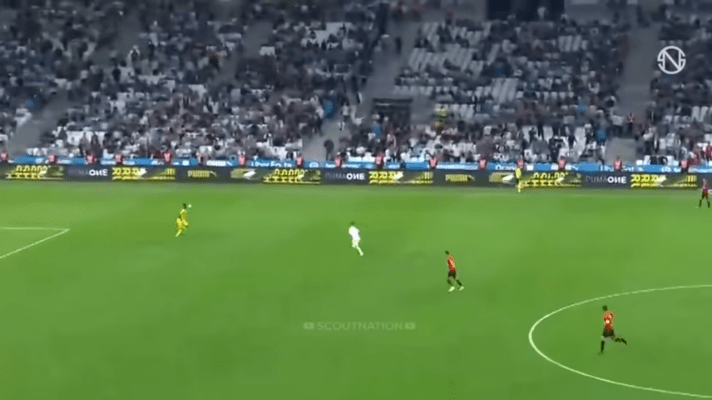

Overall, Mendy is a solid goalkeeper when it comes to pinging passes and controlling the ball. And for a club with the goalkeeper requirements that Chelsea has, Mendy’s distribution skills check all of the necessary boxes.

Sweeper keeping
Of the four areas I’ve covered in this two-part analysis — shot-stopping, aerial ability, distribution and sweeper keeping — I think I can say with full confidence that it’s the last trait Mendy struggles with the most. For as good as he is in the other categories, Mendy is far from a great sweeper ‘keeper. This is backed up by both statistics and the eye test.
Let’s take a look at the stats first. According to FBref.com, Mendy made 16 sweeper actions outside of the penalty box last season. He averaged about 0.67 outside-the-box sweeper actions per Ligue 1 appearance. Both stats put him outside of the top seven in the French top division and outside of the top 40 in Europe’s major leagues.
Though not entirely bad, neither stat paints the picture of a world-class sweeper ‘keeper. Based on the numbers, Mendy is average at best and a question mark at worst.
Mendy’s lacklustre sweeper keeping goes beyond low numbers though. When watching some of his sweeper plays, the finer details that hold him back from being a top-level sweeper become glaringly evident.
For one, Mendy will sometimes change his mind in the middle of a sweep. The Senegalese international will second-guess himself while approaching an attacker or loose ball, especially one near or outside the edge of his 18-yard box. This delayed reassessment slows Mendy down, sometimes to a full stop. It then leaves him at the mercy of an approaching attacker, who only needs to take a touch or two to round the grounded Mendy and shoot at the empty goal.
This was seen in a Ligue 2 match a few seasons ago. In this play, an opponent receives a bouncing pass just a yard or so outside of Mendy’s 18-yard box. Mendy initially approaches the pass to sweep it, but he reconsiders his involvement after noticing the pass’ bounce and the presence of a defender helping him out.
Unfortunately, Mendy was already too far off of his line and too involved in the play to recover. The attacker rounded Mendy, who could only drop to his left in a desperate attempt to bring the attacker down.
Luckily for Mendy, the attacker’s shot missed the goal. But nonetheless, this was a poor display of goalkeeping. Mendy’s reconsideration came way too late in the play — he was already too far off of his line to turn back. And as a result of Mendy’s delayed reassessment, the attacker — who didn’t have much of a scoring chance to begin with — almost took advantage of the situation.
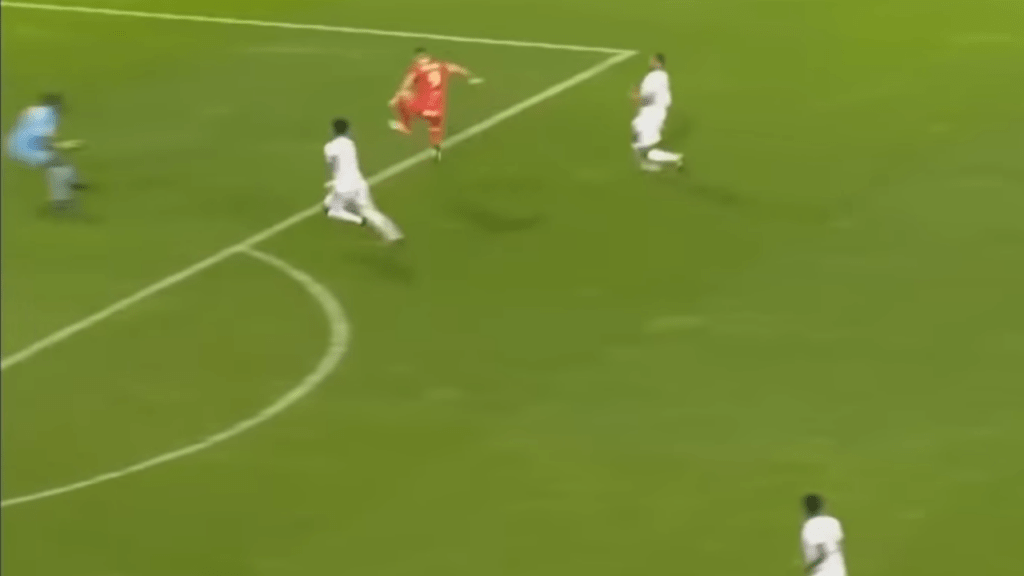

Mendy isn’t any better when he does follow through on a sweep though. He often makes the wrong initial decision to sweep, and if he follows through on his decision to sweep, it usually ends in one of two ways; he fouls the attacker and maybe even receives a card, or he gets rounded because his late challenge gives the opponent enough time to plan their next move.
Let’s look at the first point. When Mendy knows he won’t get to a loose ball first, he’ll sometimes use his body or a sliding challenge to bring his opponent down and stop the play. These will sometimes result in him being carded, putting him and his team in a bad position.
These plays normally happen as a result of Mendy making the wrong initial decision to sweep. By sweeping in a scenario in which sweeping is uncalled for, Mendy forces himself to use his body to get himself out of the situation. This sometimes results in disciplinary action being taken against him, which in turn impacts his own team’s performance. All of this could’ve been avoided with a smarter sweep.
Take this play in a 2019-20 Europa League match. As the pass is played to the edge of Stade Rennais’ 18-yard box, both Mendy and the CFR Cluj attacker sprint towards the ball. But Mendy is not a position to win this race, even with his swift pace and big steps.
To make up for his poor read of the situation, Mendy drops down and slides at the feet of his opponent, bringing him down hard. This challenge was deemed a red card-worthy offence, and Mendy was sent to the showers just five minutes into the game.
Mendy’s sending off set the stage for Rennes’ elimination from the competition. Rennes would go on to lose this game — one of their final three group games — by a 1-0 score. They’d finish the group stage with just four points to show for from six games.


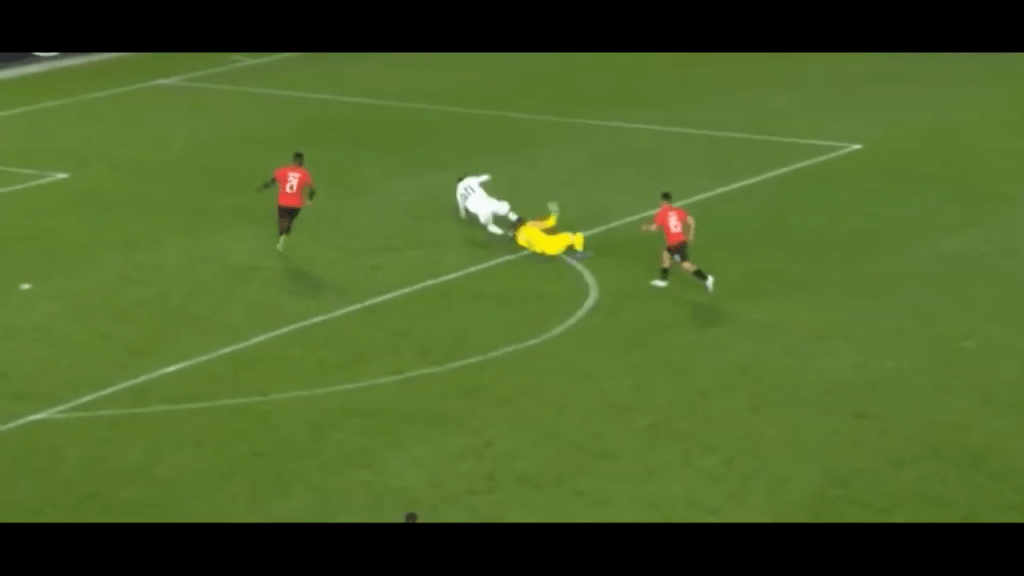
Another example comes from a French domestic competition. In this scenario, an opponent chases after a loose ball. The ball is about 35 or so yards away from Mendy’s goalline.
Despite the distance between his initial starting position and the ball, Mendy initially believes he can sweep this ball cleanly. He darts off of his line and charges at the ball.
Unfortunately, as Mendy approaches the loose ball, it becomes clear to him that he’s not going to be able to reach the ball in time. Seeing this, Mendy starts to slow down and shift his focus from the ball to the attacker. He takes a few steps to his right side and inserts his body directly in front of the attacker. Both men go down and a foul is awarded against Mendy.
Though no severe action was taken against Mendy, his recklessness could’ve easily cost him and his team in this match. He forced himself into a situation in which he had to use the body to bail himself out, and that could’ve had serious repercussions. Had he made a more intelligent sweeping decision, he would’ve avoided this risky scenario.



Mendy’s poor decision-making when it comes to sweeps also leaves him vulnerable to being exploited by attacking opponents.
As I mentioned earlier, Mendy will present opponents with a golden scoring chance by second-guessing himself yards away from his goal. But Mendy’s slow and often ill-advised decisions also allow an opponent to process Mendy’s run early and shift their movement to better take advantage of Mendy’s hopeless sweep.
By sprinting at the attacker in a scenario he has little chance of winning, Mendy is giving a chance for the attacker to analyze his approach and subsequently exploit him.
As an example, take a look at this play from a couple of seasons ago. Here, the ball is played forward for an opponent to chase. Mendy, who is positioned high in his box, decides this is a good opportunity for him to sweep.
Unfortunately, it becomes apparent that Mendy will not beat the opponent to this ball. This is also clear to the attacker himself, who adjusts his run from a straight-on approach to a more angular approach in order to better round the oncoming Mendy.
This adjustment draws Mendy’s attention to the shooter’s movement. It also allows the attacker to tap the ball past the sprawling Mendy while rounding him the other way, effectively sandwiching Mendy between the shooter and the ball. With the goalkeeper now out of the picture, the attacker is able to shoot the ball into the empty goal.
Mendy’s late approach served as a guide for the attacker to better position their run in order to exploit him. Had Mendy stayed in his initial position or timed his approach better, he would not have put himself at the mercy of the attacker.
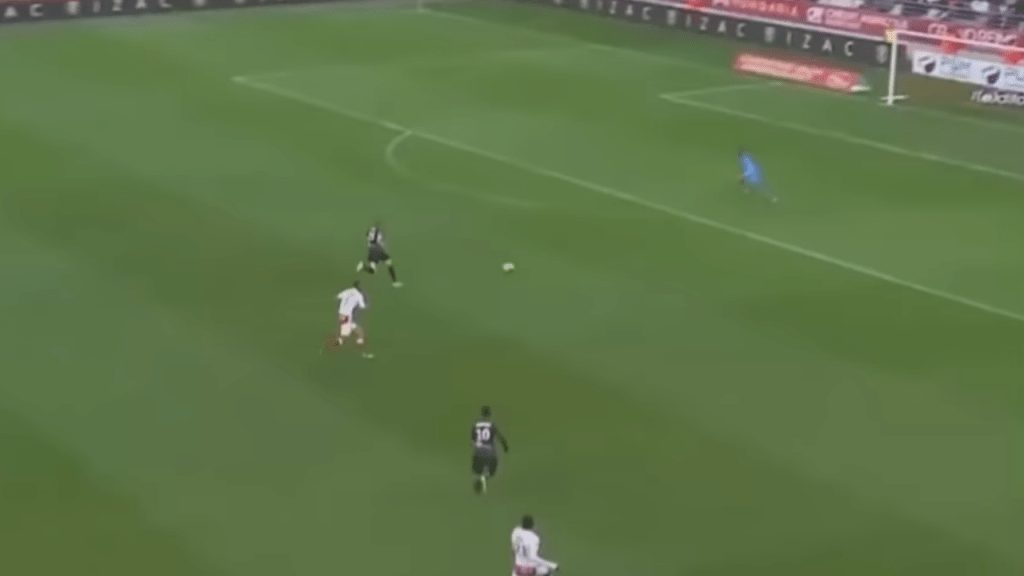

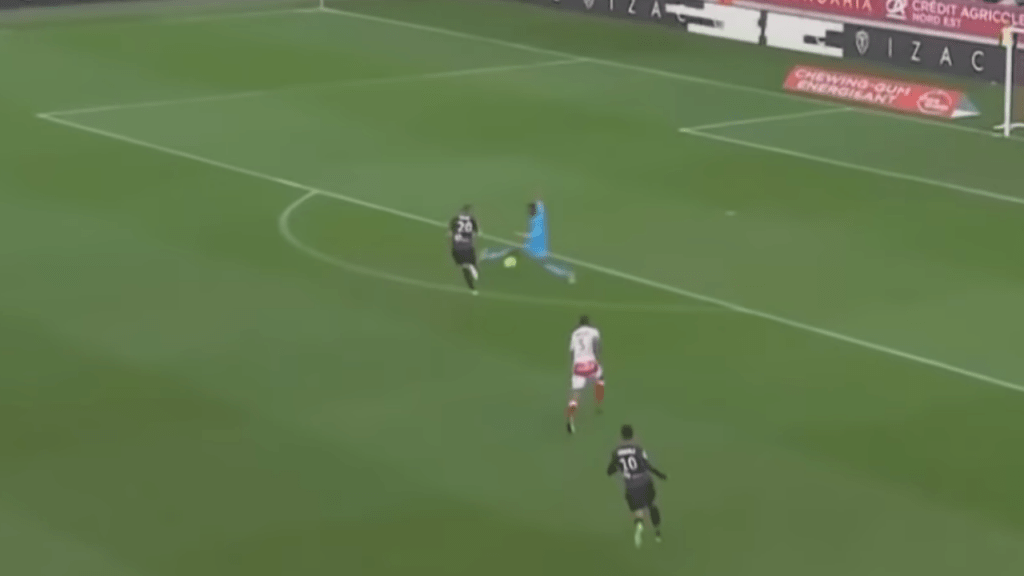
Though Mendy’s low sweeping numbers could be chalked up to Reims and Rennes’ tendency to play a low defensive line, it’s clear from the eye test that Mendy’s poor sweeping decisions also influence his low statistics.

Final thoughts
There’s no denying Édouard Mendy’s well-rounded ability. The Senegalese goalkeeper is a good shot-stopper who dominates in the air, commands his box well and is both confident and accurate with his distribution of the ball. His quality in these areas is backed up by both statistics and the eye test, and they’re a significant reason why Mendy’s been one of Ligue 1’s top goalkeepers since 2018.
His averageness in sweeper keeping could be a cause for concern. Chelsea’s tactics require a goalkeeper who’s comfortable on the ball and confident when sweeping, and Mendy’s reckless sweeper plays could cost the Blues one or two goals.
That said, it’s not enough to raise any significant questions over the validity of Mendy’s signing. The Blues need a goalkeeper who can provide a sense of reliability over the course of a season, and in the short-term, the well-rounded Mendy should be able to do that.
As for the long-term, there’s nothing that rings any major alarms in my head. Sure, Mendy will be 29 when the season ends and 33 when his five-year contract expires, but his lack of youth experience and lop-level coaching could mean that there’s potential still waiting to be tapped into. He’s already shown to be a late bloomer, so the potential for even more growth is not off of the table.
The competition that Mendy brings to the position could also be enough for Kepa Arrizabalaga to rediscover some of his pre-2019 form. Let’s face it, when a 38-year-old Willy Caballero is your back-up, your job isn’t really at risk, so it’s easy for you to take your foot off of the gas pedal.
With Mendy now in the squad, the threat of being benched becomes a reality for Kepa, and that could be enough to push him to perform at a level more expected from the world’s most expensive goalkeeper.
And if Mendy struggles? His price tag makes the loss a bit easier to swallow, and fans could chalk another season off of Kepa’s own contract, which expires in 2025. In my opinion, that’s not as bad of a potential loss as signing another goalkeeper for a record fee only to see them underperform.
All in all, Mendy is a smart signing for the Blues. He checks a number of boxes required for a Chelsea goalkeeper, and he provides the club with an upgrade in a position they desperately needed to improve in.
Mouhamad Rachini is a journalist and goalkeeper enthusiast. You can reach him on Twitter via @BlameTheKeeper.


One thought on “GK Analysis: Breaking down Édouard Mendy, Chelsea’s newest addition. (Part Two: Aerial ability, distribution & sweeper keeping)”